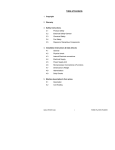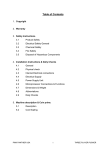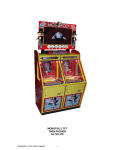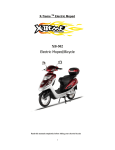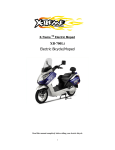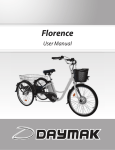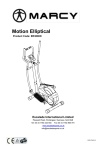Download Emmo Kingston The Urban User guide
Transcript
USER GUIDE Read this manual completely before riding your electric bicycle 1 Contents Riding Safety ………………………………………………………..3 · Safety Basics …………………………………………. ….4 · Wet Weather Riding ……………………………….……..5 · Night Riding …………………………………………. …5 · Other Reminders ……………………………………………6 Specifications …………………………………………………..….7 Wire diagram……………………………..…………..….8 Specifications……………………………………..….….8 Operation……………………………………………………..…….9 Battery Care and Maintenance…………………………………….10 Remove battery box …………………………………..…….10 Battery charging………………………………………..……11 Maintenance…………………………………………………...12 Assembly and Setup …………………………………………….. 13 Wheel assembly instructions..………………………….……….13 Steps to Startup ………………………………………………….15 2 RIDING SAFETY Like any sport, biking carries the risk of injury and damage. By choosing to ride the electric bicycle, you assume all responsibility for these risks. Thus, you need to know and practice the rules of safe and responsible riding. YOUR INSURANCE POLICIES MAY NOT PROVIDE COVERAGE FOR ACCIDENTS INVOLVING THE USE OF THIS ELECTRIC BICYCLE. TO DETERMINE IF COVERAGE IS PROVIDED YOU SHOULD CONTACT YOUR INSURANCE COMPANY OR AGENT. 3 Safety Basics: Do’s and Don’ts The Do’s o Always conduct a Safety Check before you ride your electric bicycle. Be thoroughly familiar with the controls of your electric bicycle. o Always wear an approved helmet when riding your electric bicycle. Follow the helmet manufacturer’s instructions for fit, use and care of your helmet. o Always keep body parts and other objects away from the spinning wheels of your electric bicycle. o Always wear shoes that will stay on your feet and will stay on the floorboard. o Wear bright, visible clothing that is not so loose that it can catch on moving parts of the electric bicycle or objects at the side of the road or trail. o Think about your speed, and keep your speed consistent with safe operating conditions. The Don’ts o Never ride with headphones. They mask traffic sounds, distract you from concentrating on your surroundings, and their wires can tangle in the moving parts of the electric bicycle, causing you to lose control. Never carry a passenger. The maximum carrying capacity is 350 lbs. o Never ride barefoot or wearing sandals. o Don’t jump with your electric bicycle. It puts great stress on everything from frame and forks to drive train. Riders who insist on jumping their electric bicycle risk serious damage to their electric bicycle as well as to themselves. o Never carry anything which obstructs your vision or your complete control of the electric bicycle or which could become entangled in the moving parts of the electric bicycle. o Never hitch a ride by holding on to another vehicle. o Never ride your electric bicycle while under the influence of alcohol or other drugs. o If possible, avoid riding in bad weather, when visibility is obscured, at dusk or in the dark, or when you are very tired. Each of these conditions increases the risk of accident. o Never allow children to ride. Never allow others to ride without reading and understanding these instructions. Operating Reminders and Suggestions o Review all instructions carefully before riding the electric bicycle. o Follow all rules and regulations in your area for operating a motorized bicycle. Obey the same road laws as all other road vehicles, including yielding the right-of-way to pedestrians, and stopping at red lights and stop signs. o Ride predictably and in a straight line. Never ride against traffic. 4 o Ride defensively. To other road users, you may be hard to see. o Concentrate on the path ahead. Avoid potholes, gravel, dirt, wet road, oil, curbs, speed bumps, drain grates and other obstacles. o Be alert for unexpected events, such as opening car doors or cars backing out of concealed driveways. o Be extra careful at intersections and when preparing to pass other vehicles. o Don't carry packages or passengers that will interfere with your visibility or control of the bike. Don't use items that may restrict your hearing. o Maintain a comfortable stopping distance from all other riders, vehicles and objects. Safe braking distance and forces are subject to the prevailing weather and road conditions. Wet Weather Riding Wet weather impairs traction, braking and visibility, both for the rider and for other vehicles sharing the road. The risk of accident is dramatically increased in wet conditions. In wet weather you need to take extra care. In wet conditions, the stopping power of your brakes (as well as the brakes of other vehicles sharing the road) is dramatically reduced. This makes it harder to control speed and easier to lose control. To make sure that you can slow down and stop safely in wet conditions, apply your brakes earlier and more gradually than you would under normal, dry conditions. Decrease your riding speed, avoid sudden braking, and take corners with additional caution. Keep in mind that there is a direct, but inverse, relationship between speed and controllability. Be more visible on the road. Wear reflective clothing and use safety lights. Potholes and slippery surfaces such as lane markings and train tracks all become more hazardous when wet. Night Riding A rider is very difficult for motorists to see at dusk, at night, or at other times of poor visibility. If you must ride under these conditions, check and be sure you comply with all local laws about night riding; follow the Rules of the Road, and take the following precautions: Make sure that your electric bicycle is equipped with correctly positioned and securely mounted reflectors. Make sure your clothing or cargo does not obstruct a reflector or light. Wear light colored, reflective clothing and accessories, any reflective device or light source that moves will help you get the attention of approaching motorists, pedestrians and other traffic. Ride slowly. Avoid hazards, such as potholes and curbs. Avoid areas of heavy traffic, dark areas, and roads with higher speed than limited. If possible, ride on routes already familiar to you. Ride at night only if necessary. Slow down and use familiar roads with street lighting, if possible. 5 Other Important Reminders The battery does NOT require deep discharging. re-charge its battery at least once every 30 days. If your electric bicycle is put into storage, Do not store your electric bicycle in direct sunlight for an extended time. Store your electric bicycle in a dry place. Exposing your electric bicycle to rain, snow, or other precipitation may result in damage. 6 Product features 7 Product Specifications 1. Wire diagram 2. Specifications Battery Voltage 48Volt Dc,20Ah Motor Wattage 500W Wheel Size 16 inch Top Speed 32km/h Charging Time 6-8h Distance of full charge 60 km Battery charging cycles < 300 times Max rider weight 100kgs Two rider Yes Left and Right Indicators Yes Rear View mirrors Yes 8 Operation Your new Electric Bicycle/scooter is a revolutionary new transport product using many lightweight high-powered Lithium batteries and a super high efficiency electric hub motor designed to ASSIST in the propulsion of you and your bicycle. It is important to note the following riding guidelines to ensure you get the best possible experience from your electric bicycle. Riding tip checklist When starting off from stand still, pedal bicycle up to speed then engage throttle for best results. On inclines pedaling will be required to maintain momentum. Ensure Tires are fully inflated to 30-35 PSI for bikes. Remember performance of the bike is directly related to weight of the rider and any baggage/load together with the charge in the batteries. Ensure batteries are fully charged prior to riding. Charge overnight prior to riding the next day. Never let the batteries go fully flat. This will reduce battery and bike performance. Apply chain oil periodically and clean if dirty or gummed up using a degreaser then wipe clean and apply bicycle chain oil. If your bike is equipped with lights we recommend you ride with them switched on at all times to increase visibility for you and other road users. It’s important to start pedaling for a few revolutions THEN slowly turn the throttle control and gradually bring on the power. This ensures the battery and motor is not overloaded. 9 Battery Care and Maintenance Removing the battery box Removing the battery is useful to transport the Bicycle to reduce lifting weight or to charge in a location where the bicycle may not fit etc. 1. To remove the battery box from the bike, uncover the foot pad from the bike.see figure 1-1 figure1-1 2. Lift the case and then unplug the battery. see figure 1-2, figure 1-3 figure 1-2 figure 1-3 Charging figure 1-4 Specification: 1.Input(AC) : 100-240V 2.Output: 54.60 ± 0.2V 3.Charge current:1.8±0.2A frequency:50Hz/60Hz Charging (see figure 1-4) 1.First connect to the battery charger to the charging socket located below the front of the seat or under the front seat. 10 2. Insert the power plug on the battery charger into power outlet 3. While charging, the light on the battery charger will illuminate Red. 4. When fully charged, the light will illuminate Green. ONLY CONNECT THE BATTERY CHARGER LEAD TO THE BIKE. NEVER CONNECT ANY OTHER POWER SOURCE TO THE BIKE. 5. It is recommend charging your electric bicycle for at least 15 hours the first three charging cycles. Battery Charging Instructions Be sure to charge the battery completely if you will not use it for a long period. Ideally, you should charge it every 30 days. Even a healthy battery will discharge itself slowly. Even with its power off, the electric bicycle Battery state-of-charge will decline gradually over time. Remember to fully charge the battery before your first ride. receive your new electric bicycle. The battery may be low when you 1) While charging the Battery, keep the key switch OFF. 2) Verify that you are using the correct charger for your vehicle, and that the charger input power is compatible the “house current” in your area. 3) Keep the charger and battery away from water to prevent electrical shock and shorting. The charger is intended for indoor use only. 4) Plug the end of the charger’s cord into the socket of the adaptor first. Next connect the adaptor to the electric bicycle (the charger port in located below the front of the seat). Then plug the chargers’ AC cords into the wall outlet. 5) Read the charger label to learn about the charger indicator lights, and their meanings. 6) Generally, a short drive will require a short time to re-charge, and a long ride will require a longer time. A complete (90%) discharge may require 6 hours to recharge. To prevent electrolysis (battery fluid loss by hydrogen generation,) do not charge for longer than eighteen hours. Before riding the electric bike for the first time, you must charge the batteries for 4-6 hours using the supplied 1 chargers. To charge, pull the protective cover from the charging sockets. Then plug the charger into the charging sockets, and plug the chargers into a wall outlet. WARNING Do not place the battery near heat or fire. Do not expose the chargers to water. 11 Maintenance ----Basic 1. There are two fuses in the bike. A 30Amp located in the battery box. The second fuse is a sealed fuse on the controller. 2. Clean Chain Regularly. 3. Ensure Tires are inflated to 35 PSI. 4. Adjust Brake tension via adjusting screws located at Brake lever or on Brake control lever. 5. Ensure regular servicing according to the schedule. 6. Do not attempt to change any electronic components except changing light bulbs. 7. DO not attempt to modify, open or perform maintenance on the Hub Motor. 8. Any attempt to modify or adjustment of electrical components will void the warranty. Maintenance ----Schedule Service Interval Daily Monthly Every Months Inspect Tires for wear and condition and inflation Yes Yes Yes Yes Check and adjust Brake Yes Yes Yes Yes Check operation of all lighting and horn devices. Replace globes if necessary Yes Yes Yes Yes Yes Yes Test Battery Capacity 6 Yearly Replace Wheel Baring Grease Yes Full Brake Pad Change over Yes Check condition and torque settings of wheel nuts and suspension forks Yes 12 Yes Rear Wheel Assembly Instructions 1. First, remove the two screws that hold the plastic plates on both sides of rear wheel. See figure 1-5: figure 1-5 2. Remove the screw from the end of Brake Cable, and then pull the cable out. See figure 1-6: figure 1-6 3. Remove the tightening screw. See figure 1-7 & figure 1-8 figure 1-7 figure 1-8 13 4. Remove the two nuts on both sides of the rear wheel. See figure 1-9 figure 1-9 5. Slide the wheel forward to allow slack in the chain. 6. Now slide the chain over the rear flywheel and remove the wheel from the bicycle. 14 Front Wheel Removal Instructions 1. Remove the two nuts from both sides of the front wheel. See figure 1-10 figure 1-10 2. Remove the screw from the end of Brake Cable, and then pull the cable out. Then remove the axle and spacer as shown below in figure 1-12 & 1-13. figure 1-11 figure1-12 figure1-13 3. Remove the front wheel. Front Wheel Installation Instructions 1. 2. 3. 4. Set your bike on a strong table or workbench to make access easier. Lift the front forks and install the front wheel. Ensure the locking washers are inserted into the holes on the forks. Insert the axle and spacer as shown above (in reverse) Install the two nuts on the end of the axle and tighten. 15 Other Helpful Instructions Pedals 1. Use a pedal wrench of 16mm spanner to tighten pedals. 2. Check and tighten pedal crank bolts with 14mm socket. 3. Tires 1. Inflate tire using a pump to 30-35psi. Remember lower tire pressures will negatively impact performance by causing too much resistance. 2. Chain 1. Give the train a light drop of bicycle chain oil or sewing oil .Do not use RP7 type lubricants. 2. Mirrors 1. Insert rear mirrors into slot ensuring a match for left and right Etc. 2. Twist until tight with Allen key. Don’t over tighten. see figure 1-12: figure 1-12 Battery 1. Insert battery case and plug in the opposite way to the way you removed it. 2. The battery will have enough charge for a short ride/use for your first ride. 3. Charge the battery overnight. 4. 16 Windshield 1. Locate the 5 pieces needed for this windshield. figure 1-13. Install it as shown in figure 1-13. First find the small gold clip(as shown in figure 1-13 2. Place the windshield correctly. 3. Use the five screws and tighten them lightly. Final Check 1. Check all nuts screws and bolts including ones not mentioned in the set up, for tightness and fit before riding. 2. Dispose of packaging thoughtfully and responsibly. Recycle cardboard. 3. Ensure charger is functioning both connected to bicycle and directly to the battery pack when removed from bicycle. 4. When connected to the bicycle, turn ignition on , charging voltage should be around 40-44volts on the meter. Test by connecting and observing charging light on the charger. 17

















